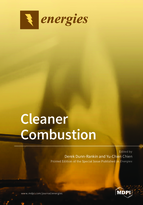Cleaner Combustion
A special issue of Energies (ISSN 1996-1073). This special issue belongs to the section "B: Energy and Environment".
Deadline for manuscript submissions: closed (31 March 2019) | Viewed by 47791
Special Issue Editors
Interests: combustion; sprays; particle transport; non-intrusive optical diagnostics
Special Issue Information
Dear Colleagues,
The Special Issue in Energies on “Cleaner Combustion” focuses on how the combination of fuel treatment, effective energy extraction, and emission mitigation in combustion can be optimized to reduce the environmental impact that threatens living systems because humans rely heavily on energy for basic necessities and economic development. We refer to “cleaner combustion” as an explicit acknowledgment that any improvements in this critical technology can have a significant global impact because of the ubiquitous nature of combustion. A growing population and growing standards of living have produced explosive growth in energy demand, and the environmental upset has started feeding back. This Special Issue includes a spectrum of research on cleaner combustion that helps balance our needs for energy with cognizant respect for the environment.
The goal of this collection is to identify the challenges and improvements of existing energy generation strategies in combustion, as well as reaching various pathways that resolve combustion emissions. The topics range from combustion and flame research that directly or indirectly impact the optimization of combustion processes using conventional carbon-based or hydrocarbon fuels, to options leading to a cleaner combustion outcome by using alternative fuels, biofuels, or low carbon fuels, or including new methods to process exhausted gases.
Prof. Dr. Derek Dunn-Rankin
Dr. Yu-Chien Chien
Guest Editors
Manuscript Submission Information
Manuscripts should be submitted online at www.mdpi.com by registering and logging in to this website. Once you are registered, click here to go to the submission form. Manuscripts can be submitted until the deadline. All submissions that pass pre-check are peer-reviewed. Accepted papers will be published continuously in the journal (as soon as accepted) and will be listed together on the special issue website. Research articles, review articles as well as short communications are invited. For planned papers, a title and short abstract (about 100 words) can be sent to the Editorial Office for announcement on this website.
Submitted manuscripts should not have been published previously, nor be under consideration for publication elsewhere (except conference proceedings papers). All manuscripts are thoroughly refereed through a single-blind peer-review process. A guide for authors and other relevant information for submission of manuscripts is available on the Instructions for Authors page. Energies is an international peer-reviewed open access semimonthly journal published by MDPI.
Please visit the Instructions for Authors page before submitting a manuscript. The Article Processing Charge (APC) for publication in this open access journal is 2600 CHF (Swiss Francs). Submitted papers should be well formatted and use good English. Authors may use MDPI's English editing service prior to publication or during author revisions.
Keywords
- cleaner combustion
- low NOx
- low carbon fuel
- biofuel
- alternative fuel
- exhaust gas cleanup
- emission control
- MILD combustion
- highly preheated combustion
- oxy-fuel
- chemical looping






